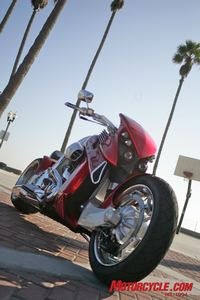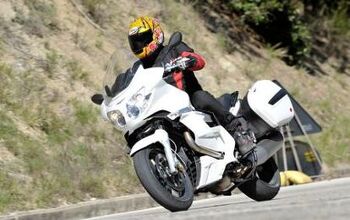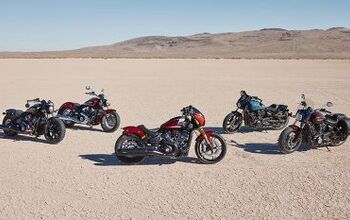2008 Travertson V-REX Review - Motorcycle.com
If Angelina Jolie strolled down Main Street naked, perhaps with her hair on fire, she might come close to attracting the amount of attention the Travertson V-REX does.
Such is the life of the rider of this science-fictionish contraption, an instant celebrity who is continually barraged with questions each and every time the bike comes to a stop. And, even then, many wouldn’t wait until it was parked, as several times cell phone cameras were dangled out open car windows and wide-eyed, smiling gawkers would yell out above the breeze, “Hey, what the hell is that thing?!”
Yes, the V-REX is as subtle as a ballpeen hammer to the forehead. And we imagine that’s the way its small but well-heeled market likely prefers it.
This cartoon on wheels was brought to life by one of the clever people who created the Y2K jet-turbine bike made famous by the inimitable Jay Leno, a certified bike nut who delights in telling the story of watching the front bumper of a Camry melting from the intense heat of the turbine’s exhaust after it had pulled up too close at a stoplight.
This proved to be easier said than done. Cameron, working in the digital realm, wasn’t constrained by bothersome details like actual engineering principles. So it was up to Travert to envision a three-dimensional structure that remained true to Cameron’s art project while not collapsing from the stresses of an elongated 79.2-inch wheelbase. Consider the Star Raider, one of the longest bikes MO has ever tested, whose wheelbase is almost 9 inches shorter.
Travert, a Frenchman transplanted to Florida, came up with a unique cast-aluminum frame structure that doubles as the fuel tank. A framework of steel tubes stretch over the engine to create the steering-head section and use the V-Rod’s Revolution motor as a stressed member. The company claims a 670-lb dry weight.
“The front suspension is comparable to a modern street motorcycle back swingarm/monoshock arrangement installed at the front of the motorcycle and pivoting on a neck axis,” Travert told Motorcycle.com. “This design eliminates all the flex of a long classic front fork and also is what gives the incomparable stability plus ease to the V-REX at low and high speed, and it also eliminates nose dive under braking.”
And what powers such a futuristic contraption? Hydrogen? Dilithium crystals? Nope, just a good ol’ Porsche design in the form of a Harley-Davidson Revolution motor. The liquid-cooled, DOHC V-Rod engine is used as a structural element, and Travert wisely chose to keep the entire Harley powertrain intact, including its fuel-injection system and electronics. A belt drive spins a meaty 280/35-18 Metzeler ME880 tire out back, mounted on a single-sided aluminum swingarm.
Short folks will love that their butts will be just 26 inches off the pavement when sitting in a seat that feels like former MO editor Sean Alexander cupping your ass (don’t ask us how we know). Meanwhile, switchgear, instruments and controls are familiar to anyone with seat time on a late-model Harley. Thumbing the H-D starter button ignites the 1250cc V-Twin, and the resulting bark out the bespoke chrome exhaust system is much blattier than allowed from any stock Hog.
Two aspects become immediately noticeable: First, that front end is waaaaay up there somewhere near the next zip code; second, the funky front end of the V-REX offers a surprisingly light feeling at low or no speed.
Once rolling, the V-REX’s straight-line behavior is about what you’d expect from a 9-foot long, fat-tired cruiser: comfortable and resistant to leaning. The front Metzeler 140/70-18 is as fat as the rear tire of a 1990’s FZR600, but steering response isn’t any worse than some choppers I’ve tested. Meanwhile, the Revolution powerplant and transmission operate just as they do in a V-Rod, albeit with slightly fluffier throttle response.
The V-REX offers another odd sensation is felt while braking, as the front end rises when the binder is applied aggressively (as opposed to diving) due to the front swingarm’s geometry. Incidentally, that rim-mount front brake rotor and its six-piston caliper are borrowed from a Buell sportbike.
I had to chuckle when I read the Robb Report Motorcycling’s impression of the V-REX: “At speed it glides through corners, soaks up unfriendly pavement, makes U-turns with no worries and stops crisply.”
Although we’re amazed that such precocious design as the V-REX actually goes, turns and stops like a motorcycle, we’re a little more discriminating with our evaluation. Most of the “gliding through corners” is done by the footpegs or exhaust pipe, as the slammed and lengthy scooter has a dearth of cornering clearance, scraping hard parts even at modest speeds through turns. And if your turns are of the U variety, you’d best be on a multi-lane road with plenty of extra room. The V-REX is awkward during such maneuvers, with a floppy front end and limited steering lock.
But, really, no one should be surprised or offended by a lack of agility, as this is a characteristic of most high-end radical customs. This genre of bike works best when profiling up and down Main Street.
Except the V-REX stands apart from any typical chopper – it’s a chassis and a shape unlike anything else on the road, and it magically swivels necks at a higher rate than any bike we’ve tested. And an observer doesn’t need to be a motorcycle connoisseur to appreciate and be moved by the V-REX’s far-reaching and alluring unique design, evidenced by the never-ending stream of cell-phone cameras and toothy smiles it inspires.
The V-REX also appeals to those who understand the cost of creating a piece of rolling sculpture. One of the locations we used for photos was Ford’s Premier Automotive Group facility in Irvine, California, where we again gathered another crowd. Even the car guys knew they were looking at something special, and they examined it from all angles while pointing and smiling. After admiring it for awhile, one man asked a pointed question.
“How much?”
“40 grand and change,” I replied
“That’s it?!” he responded incredulously.
Yes, $43,990 sounds like a lot of coin to me. On the other hand, there’s no shortage of $40,000 choppers out there that, aside from paint, look a lot like other $40,000 choppers. Speaking of paint, the V-REX can be ordered in one of 11 different colors.
The V-REX proudly and defiantly thumbs its nose at the status quo, and in doing so, it challenges the two-wheel establishment to think outside the box and explore what is possible. And for those who want something sportier, you’ll want to wait for the VR-2, the next production model from Travertson.
If you want the instant celebrity status the V-REX brings, surf on over to WeRentMotorcycles.com and you’ll find the V-REX we tested available for $300 a day. Jack Reynolds, the owner of this new business based out of Newport Beach, California, has several other attention-getters in his stable, such as the Can-Am Spyder, a Boss Hoss 502 and, later this year, a Ducati Desmosedici RR. If those are a bit too wild for you, Reynolds also has more typical rides such as a Harley Road King, a Kawi Concours 14 and some BMWs.
Related Reading:
Tim Cameron Design
Travertson Motorcycles
More by Kevin Duke


































Comments
Join the conversation